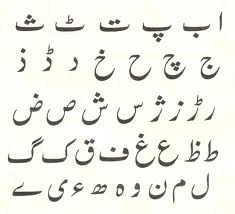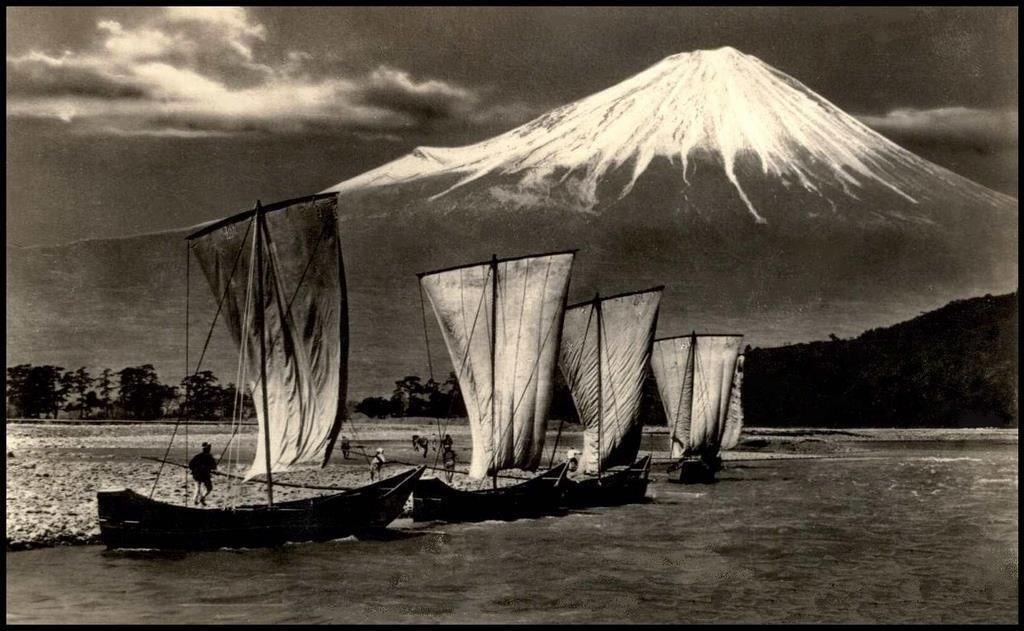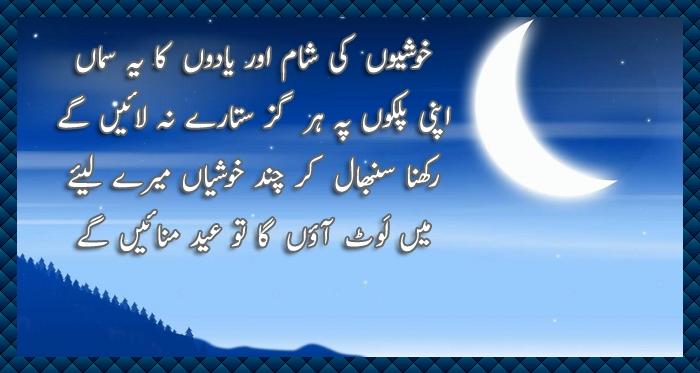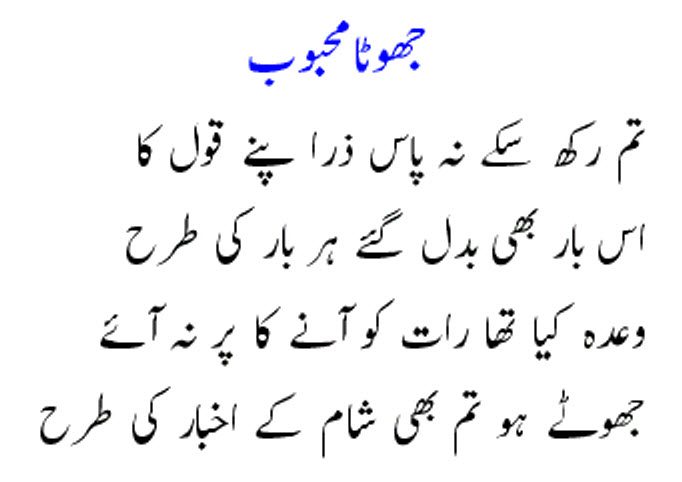Pakistani Urdu Poetry Biography
Source:- Google.com.pkThe Death of the Urdu Script
Can Microsoft and Twitter save the dying Urdu nastaliq script from the hegemony of the Western alphabet and an overbearing Arab cousin?
ali eterazali eteraz in Writers on Writing
A few years ago the Swedish store IKEA changed its font from Futura to Verdana and the Futura loyalists, fifty years faithful, created a veritable media storm. But most of us didn’t care, because to us both fonts are very similar.
Now imagine if the Futura loyalists had been faithful for hundreds of years; had produced poets of Shakespeare’s caliber that had written in Futura; and had institutions and schools where the stylish rendering of Futura script was mastered over the course of a lifetime, only to one day be told that not only could they no longer write in Futura, but they had to write in Braggadocio, and if they didn’t like that then they could write in Chinese. Would it be justified for the Futura people to be angry then?
Well, when it comes to the digital world, this exact scenario is playing out for Urdu, a South Asian language spoken by anywhere between 100 — 125 million people in Pakistan and India, and one of Pakistan’s two official languages. Urdu is traditionally written in a Perso-Arabic script called nastaliq, a flowy and ornate and hanging script. But when rendered on the web and on smartphones and the entire gamut of digital devices at our disposal, Urdu is getting depicted in naskh, an angular and rather stodgy script that comes from Arabic. And those that don’t like it can go write in Western letters.
Here’s a visual comparison taken from Wikipedia.
Nastaliq v. Naskh. Courtesy Wikpedia.
Looking at the picture, the discerning eye may immediately realize why naskh trumps nastaliq on digital devices. With its straightness and angularity, naskh is simply easier to code, because unlike nastaliq, it doesn’t move vertically and doesn’t have dots adhering to a strict pattern. And we all know how techies opt for functionality.
Utility being the mother of expansion, naskh is quickly phasing out nastaliq on the web. BBC-Urdu and Urdu Voice of America both use naskh; so does Alarabiya Urdu. And if you want to write an SMS in nastaliq, you must use naskh as well. Same holds true for social media: Facebook, naskh; Twitter, naskh; blogs, naskh.
In fact, naskh is so dominant now, that when the appropriately named D.E.I.T.Y. — The Department of Electronics and Information Technology of the Government of India — released an Urdu keyboard app for Windows and Android, they released twelve naskh fonts and only one nastaliq font.
When I read about that, I was thoroughly deflated. New Delhi, the seat of the Indian government, is one of the long-standing hearts of the Urdu language. It is where Ghalib, the Urdu Shakespeare, was from. And yet there in Delhi, naskh, this pretender font, was in ascension, all because it was easier to code.
Utility had defeated tradition.
It reminded me of a couplet by Ghalib.
Poetry by Mirza Asadullah Khan Ghalib.
“I can get another if I break it/so a clay cup trumps a grail.”
The ease of naskh hasn’t meant that those who wanted to keep nastaliq in circulation simply gave up. In one of the most fascinating instances of online writing, nastaliq writers started making websites where they used specialized software to produce image files, which were then uploaded to the webpage. One of Pakistan’s leading newspapers, Jang Urdu, is a very good example of how this image-based-writing works. You can’t copy and paste their text. But if you wanted to save some of the text, you could download the image file. This tactic has worked quite well and has spread to the lowest level. Many an Urdu poet on Facebook, rather than typing his ghazal into the status update (because that would mean writing in naskh script), will instead upload an image file in nastaliq. People even e-mail entire books to each other, in individual images.
Constantly uploading image files to communicate maybe romantic (or it can make you feel like a second class digital citizen), but it is not practical. As a result, like the enterprising people Urdu-speakers are, when it comes to the web, most write Urdu in Western transliteration. In other words, entire SMS conversations, to websites, to blogs get written in Western letters. In Roman Urdu, if you wanted to say “Long Live Wikipedia!” you would simply write, “Wikipedia Zindabad!” It just works.
This Romanized Urdu dominates smartphones and Facebook and Twitter. Writing in Roman letters also makes it easier to switch in and out of English. As an example, take a recent Tweet by the human rights activist Sana Saleem: “If you’ve read my tweets, or my work, I hardly ever cuss. Sorry about that, par bus boat hogaya, buss kardo bass.”
To me, as a writer, that is an astonishing piece of text. Not only are we looking at two languages collapsed into one, but the Romanized part is a language that has not yet been formalized; it is literally under construction due to the pressure exerted by the exigencies of the internet. What’s even more interesting about this tweet is that in the Roman Urdu part of the Tweet, Sana is actually making a veiled reference to an anti-terrorist advertisement that was popular on GEO TV, an Urdu language station. In the ad a little boy is yelling at the adults for all their violence, using the words, “bass kardo bass” or “enough is enough.” So by appropriating anti-terrorist tropes to bash the trolls attacking her, Sana is also acting like an ironic translator. And Urdu speakers do this kind of thing constantly. It is pretty remarkable. Sana even rhymed the English and the Roman Urdu.
Obviously, part of the reason that Roman Urdu has taken off is because of the hegemony of the Western alphabet in our world today. The Roman alphabet is darn near universal. Indonesians and Turks recognized this long ago and forcibly converted their alphabet to Roman letters under the hands of enlightened despots. Urdu, however, is being pushed into the same position, except by the hand of Silicon Valley.
The second reason that Urdu-speakers are turning to Roman transliteration is because we — can I use that pronoun? — hate writing and reading in naskh. See the above comparison to Braggadocio in English. It isn’t that you can’t make the letters out; but it is cognitively dissonant and interferes with the essential ease of language. The disinterest in naskh creates a feedback loop to Roman Urdu. And the whole thing is happening in silence.
I admit that as a “Fusion” or “ABCD” — which is what native Pakistanis pejoratively call Americans of Pakistani descent — my obsession with writing on digital devices with nastaliq is extremely unusual. I am not an Urdu writer; I write fiction and non-fiction in English. My canon is Poe, Emerson, Wallace Stevens; not Ghalib, Iqbal, and Faiz. And Urdu is not even my mother tongue. However, what is true is that Urdu is intrinsically connected to the “Pakistan” side of my Pakistani-American identity and I have every intention of fighting for its preservation.
There is also a political dimension for opting for the traditional nastaliq. In short, naskh carries an “Arab” connotation because it is the preferred script for the Arabic language (ironically invented by a Persian). Due to recent geo-politics, such as the enthronement of the Saudi backed Wahhabi dictator Zia ul Haq in 1980's Pakistan, as well as the politicization of the history of Arab imperialism over India, Arab intrusion in South Asian matters is always contested. One of the quickest ways to create an argument among Pakistanis is for one person to say the Arabic “Allah Hafiz” for goodbye instead of the Urdu “Khuda Hafiz.” By fighting for nastaliq in the face of naskh, then, I feel that I am rejecting the cultural Arabization of South Asia.
There is one more reason why nastaliq matters. It is, literally, calligraphy become language. Until recent decades, young boys and girls in Indian and Pakistani schools carried around rectangular wooden board called a takhti. On these, using a bamboo reed pen and an inkwell filled with a little gauze to make the dipping easier, they practiced writing every letter of the Urdu alphabet with painstaking care. Then when the lesson was over they washed the ink off the board and smoothed the surface with a bar of stucco clay and started on the next lesson. I worked on a takhti when I was living in Pakistan. The earthen smell of a freshly washed and resurfaced board haunts me to this day.
And I am not alone in the love of the takhti. The Pakistani-American poet Shadab Zeest Hashmi describes the experience of producing nastaliq on a takhti like this:
Penmanship was a dying art even in my school days, but luckily I learned to use a traditional bamboo pen at home; forming letters of the nastaliq script of Urdu in jet-black ink. Layering the hand held wooden board with white clay paste, drying it in the sun, and writing with a reed pen that needed to be filled every few minutes, was messy and frustrating. As I fumbled with the materials, I began to acknowledge the muscles that are engaged in the physical work of writing. Forming letters became a fascinating study of lines and curves, symmetry and alignment. Soon I began to have a deeper appreciation for the calligraphic pieces hanging in the house. I noticed how well the artists conformed to rules and how gracefully they deviated, playing with form to create visual effects that influenced the meaning of the words. In learning to see patterns and variations, I was learning to extend myself, to make imprints of my inner life onto the outer reality of the page. Words had created visual fields for me—allowing endless possibilities for expressing meaning.
Pakistani Urdu Poetry Urdu Poetry Sad SMS Pic Wallpapers 2 Lines Dosti In Urdu In English Wasi Shah 2 Lines Faraz Pictures
Pakistani Urdu Poetry Urdu Poetry Sad SMS Pic Wallpapers 2 Lines Dosti In Urdu In English Wasi Shah 2 Lines Faraz Pictures

Pakistani Urdu Poetry Urdu Poetry Sad SMS Pic Wallpapers 2 Lines Dosti In Urdu In English Wasi Shah 2 Lines Faraz Pictures

Pakistani Urdu Poetry Urdu Poetry Sad SMS Pic Wallpapers 2 Lines Dosti In Urdu In English Wasi Shah 2 Lines Faraz Pictures

Pakistani Urdu Poetry Urdu Poetry Sad SMS Pic Wallpapers 2 Lines Dosti In Urdu In English Wasi Shah 2 Lines Faraz Pictures

Pakistani Urdu Poetry Urdu Poetry Sad SMS Pic Wallpapers 2 Lines Dosti In Urdu In English Wasi Shah 2 Lines Faraz Pictures

Pakistani Urdu Poetry Urdu Poetry Sad SMS Pic Wallpapers 2 Lines Dosti In Urdu In English Wasi Shah 2 Lines Faraz Pictures

Pakistani Urdu Poetry Urdu Poetry Sad SMS Pic Wallpapers 2 Lines Dosti In Urdu In English Wasi Shah 2 Lines Faraz Pictures
Pakistani Urdu Poetry Urdu Poetry Sad SMS Pic Wallpapers 2 Lines Dosti In Urdu In English Wasi Shah 2 Lines Faraz Pictures
Pakistani Urdu Poetry Urdu Poetry Sad SMS Pic Wallpapers 2 Lines Dosti In Urdu In English Wasi Shah 2 Lines Faraz Pictures

Pakistani Urdu Poetry Urdu Poetry Sad SMS Pic Wallpapers 2 Lines Dosti In Urdu In English Wasi Shah 2 Lines Faraz Pictures
Pakistani Urdu Poetry Urdu Poetry Sad SMS Pic Wallpapers 2 Lines Dosti In Urdu In English Wasi Shah 2 Lines Faraz Pictures

Pakistani Urdu Poetry Urdu Poetry Sad SMS Pic Wallpapers 2 Lines Dosti In Urdu In English Wasi Shah 2 Lines Faraz Pictures

Pakistani Urdu Poetry Urdu Poetry Sad SMS Pic Wallpapers 2 Lines Dosti In Urdu In English Wasi Shah 2 Lines Faraz Pictures

Pakistani Urdu Poetry Urdu Poetry Sad SMS Pic Wallpapers 2 Lines Dosti In Urdu In English Wasi Shah 2 Lines Faraz Pictures
Pakistani Urdu Poetry Urdu Poetry Sad SMS Pic Wallpapers 2 Lines Dosti In Urdu In English Wasi Shah 2 Lines Faraz Pictures

No comments:
Post a Comment